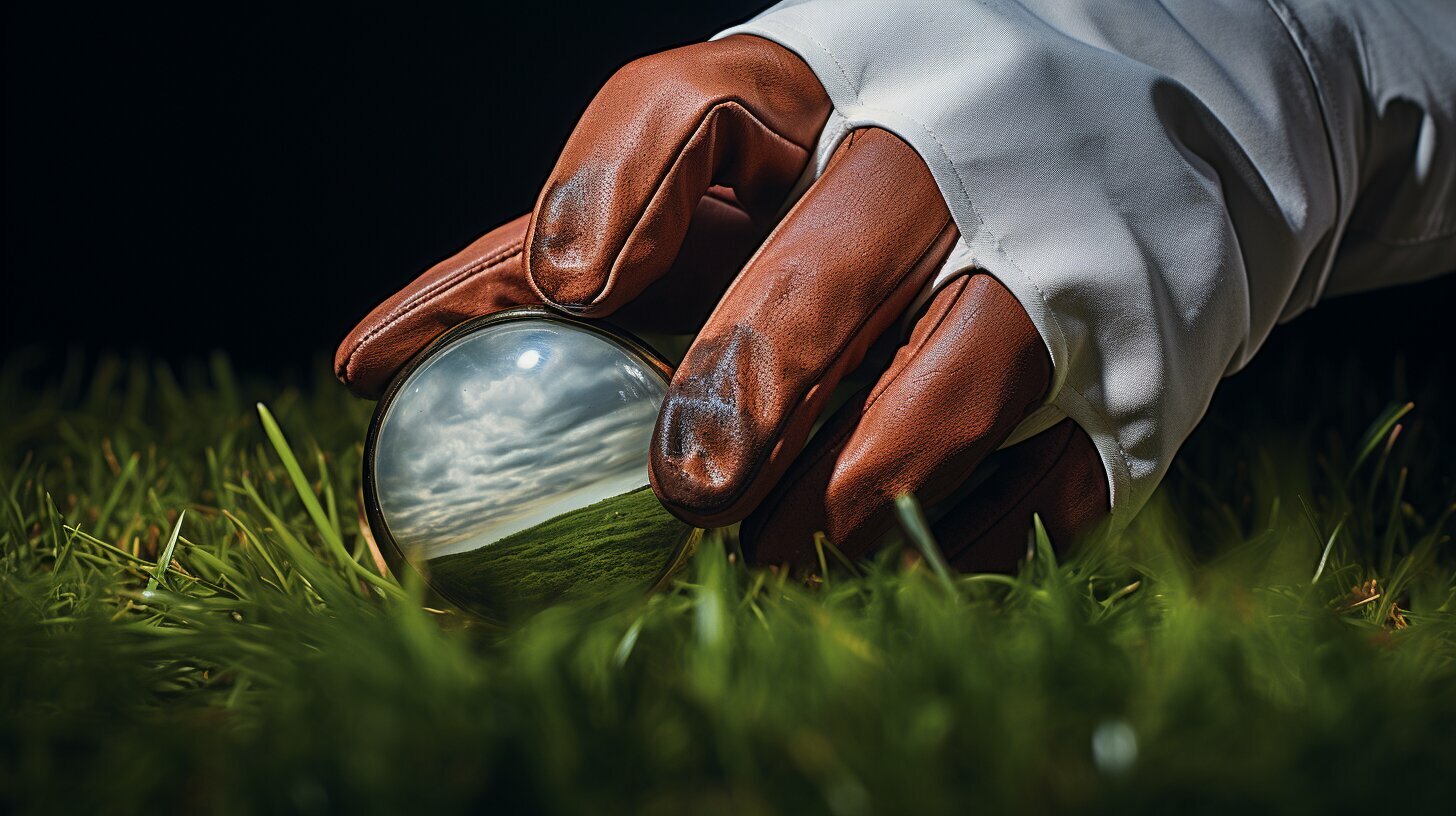Uncovering the Mystery: Why Do Golfers Wear Gloves?
Golfers wear gloves for various reasons, ranging from improving their grip to protecting their hands from blisters and calluses. Wearing a glove on the lead hand helps ensure a secure hold on the club, while leaving the trailing hand ungloved improves feel and touch for precise shots. Gloves also help manage moisture, providing stability and control during the swing. Whether golfers choose to wear one or two gloves, or no gloves at all during putting, is a matter of personal preference.
Key Takeaways:
- Golfers wear gloves to improve grip and prevent blisters and calluses.
- Wearing a glove on the lead hand provides a secure hold on the club.
- The trailing hand is often left ungloved for improved feel and touch.
- Gloves help manage moisture and provide stability during the swing.
- Golfers have the option to wear one or two gloves based on personal preference or specific needs.
Enhancing Grip and Preventing Injuries
One of the primary reasons golfers wear gloves is to enhance their grip on the golf club, allowing for a more secure and controlled swing. The function of golf gloves in improving grip cannot be overstated. The material used in the gloves provides a tacky surface that creates friction between the hand and the club, preventing slippage during the swing. This increased grip not only helps maintain control of the clubface but also allows for greater power and accuracy in the shot.
Golf gloves also play a crucial role in preventing injuries. The repetitive motion of swinging the golf club can lead to blisters and calluses on the hands. By wearing a glove on the lead hand, which is the hand that experiences the most pressure and stress during the swing, golfers can significantly reduce the risk of developing these painful skin conditions. The glove acts as a protective barrier, cushioning the hand and preventing friction, thus keeping blisters and calluses at bay.
Additionally, wearing a golf glove contributes to the overall stability and control of the swing. The glove helps ensure a firm hold on the club, preventing the club from slipping or twisting in the hands. This stability translates to a more consistent swing and improved shot accuracy. By keeping the hands secure on the club, golfers can confidently execute their swings without worrying about losing control or mishitting the ball.
It is worth mentioning that while most golfers wear one glove on their lead hand, there is flexibility and adaptability when it comes to glove preference. Some golfers opt to wear two gloves for added grip or because of specific needs such as blisters or cold weather conditions. On the other hand, some golfers choose not to wear gloves at all during putting to better feel the putter through the stroke. Ultimately, the decision to wear gloves or not and the number of gloves to wear is a matter of personal choice, taking into consideration comfort, grip preference, and specific playing conditions.
| Golf Glove Function | Do Golf Gloves Improve Grip? | Reasons to Wear Golf Gloves |
|---|---|---|
| Enhances grip on the golf club | Yes, golf gloves improve grip by providing a tacky surface | Prevents blisters and calluses |
| Prevents slippage during the swing | Increased grip allows for more secure and controlled swings | Improves stability and control |
| Cushions the hand, reducing the risk of hand injuries | Offers adaptability based on personal preference and needs |
Managing Moisture and Providing Stability
Golf gloves play a crucial role in managing moisture on the hands, preventing them from becoming slippery during the swing. When playing golf, it’s natural for the hands to perspire due to the physical exertion and the pressure of the game. This perspiration can make the grip slippery, leading to a loss of control and accuracy in the swing. However, by wearing golf gloves, this issue can be effectively addressed.
The material used in golf gloves is designed to absorb sweat and keep the hands dry. This not only enhances the golfer’s grip on the club but also provides stability and control throughout the swing. The moisture-wicking properties of golf gloves allow players to maintain a firm and secure hold on the club, resulting in more accurate shots and increased overall performance.
In addition to managing moisture, golf gloves also contribute to stability during the swing. The gloves provide a consistent surface between the hands and the club, reducing the risk of slippage and maintaining a solid connection. This stability ensures that the energy from the swing is effectively transferred to the club, resulting in powerful and controlled shots.
Table: Comparison of Popular Golf Gloves
| Glove Brand | Material | Features | Price Range |
|---|---|---|---|
| Brand X | Synthetic leather | Moisture-wicking, adjustable closure | $20-$30 |
| Brand Y | Cabretta leather | Superior grip, breathable | $30-$40 |
| Brand Z | Mesh and synthetic blend | Lightweight, flexible | $15-$25 |
When choosing a golf glove, it is important to consider the material, features, and price range that best suit your needs and preferences. Whether you prefer synthetic leather for durability, cabretta leather for a superior grip, or a lightweight blend for flexibility, there are various options available in the market to cater to different golfers.
In conclusion, golf gloves provide significant advantages in managing moisture and providing stability during the swing. The moisture-wicking properties of the gloves help prevent slipperiness, while the consistent grip ensures a secure hold on the club. By investing in a high-quality golf glove that suits your individual needs, you can enhance your performance on the course and enjoy a more comfortable and confident game.
Glove Preference and Adaptability
The number of gloves a golfer chooses to wear and the decision to go gloveless during putting are personal preferences that vary among players. For some golfers, wearing a single glove on the lead hand is sufficient to improve grip and prevent blisters and calluses. This allows for a secure hold on the club while still maintaining a heightened sense of touch and feel with the ungloved trailing hand. The choice between wearing one or two gloves depends on individual needs and preferences.
Some golfers may opt to wear two gloves for added protection and grip, particularly if they have a history of blisters or if they are playing in cold weather conditions. Wearing two gloves can help provide extra insulation and prevent the hands from becoming too cold, thus ensuring optimal performance. Additionally, two gloves can further enhance grip and stability, especially for players with sweaty palms or those who generate a lot of power in their swing.
On the other hand, some golfers may choose not to wear gloves at all during putting. By going gloveless, they can have a better feel for the putter and the greens, allowing for more precise and delicate strokes. Without the barrier of a glove, golfers can make subtle adjustments and gauge the speed and direction of the putt with greater sensitivity. Going gloveless during putting is a personal choice that enables golfers to fine-tune their touch and control on the greens.
| Preference | Description |
|---|---|
| One Glove | A single glove on the lead hand for improved grip and prevention of blisters and calluses. |
| Two Gloves | Wearing gloves on both hands for added protection, grip, and insulation in cold weather conditions. |
| Gloveless Putting | Choosing not to wear gloves during putting for enhanced feel, touch, and control on the greens. |
In conclusion, golfers have the flexibility to adapt their glove usage based on their specific needs and preferences. Whether it’s wearing one glove, two gloves, or opting for a gloveless approach during putting, the ultimate goal is to achieve the perfect balance of grip, feel, and control to enhance performance on the course.
Conclusion
Golf gloves serve a vital purpose in enhancing a golfer’s performance by improving grip, preventing injuries, and providing stability, making them an essential piece of equipment on the course.
The primary purpose of wearing golf gloves is to improve grip. By wearing a glove on the lead hand, which experiences the most pressure and stress during the swing, golfers ensure a secure hold on the club. This improved grip translates to better control and accuracy in their shots. On the other hand, the trailing hand is often left ungloved to enhance feel and touch for more precise shots.
In addition to grip enhancement, wearing a golf glove helps prevent blisters and calluses. The glove acts as a protective barrier between the hands and the club, reducing friction and minimizing the risk of painful skin irritations. This is especially important for golfers who spend hours practicing and playing on the course.
Furthermore, golf gloves assist in managing moisture. The materials used in these gloves are designed to absorb sweat, helping to maintain a dry and comfortable grip. This not only reduces the risk of slipping during the swing but also provides stability and control, enabling golfers to execute consistent and powerful shots.
While it is common for golfers to wear one glove, the option to wear two gloves exists. Some golfers may choose to wear two gloves for added protection or if they have specific needs, such as blisters or cold weather conditions. However, it is worth noting that some golfers may decide not to wear gloves at all during putting. This allows them to have a better feel for the putter, facilitating a smoother and more accurate stroke.
In the end, the decision to wear gloves and the number of gloves worn is a matter of personal preference. Golfers have different styles, preferences, and needs, which may impact their choice regarding gloves. Nevertheless, the importance of golf gloves in improving grip, preventing injuries, managing moisture, and providing stability cannot be understated. They are an essential tool that contributes to a golfer’s overall performance and enjoyment of the game.
FAQ
Why do golfers wear gloves?
Golfers wear gloves primarily to improve their grip on the club and prevent blisters and calluses.
Which hand should golfers wear gloves on?
Golfers should wear gloves on their lead hand, which is the hand that experiences the most pressure and stress during the swing.
Do golf gloves improve grip?
Yes, wearing a glove improves grip by providing a secure hold on the club.
Why do golfers sometimes wear two gloves?
Some golfers prefer to wear two gloves for additional grip and to address specific needs such as blisters or cold weather conditions.
Do golfers wear gloves while putting?
Some golfers choose not to wear gloves during putting to have better feel and touch on the putter.
How do golf gloves manage moisture?
Golf gloves are designed to absorb sweat and manage moisture, reducing the risk of slipping during the swing.
Can golf gloves provide stability and control?
Yes, golf gloves provide stability and control by maintaining a firm grip on the club throughout the swing.
Are golf gloves a matter of personal preference?
Yes, whether to wear gloves, how many to wear, and other preferences regarding golf gloves are a matter of personal choice.
- Discovering Why Do Women Wear Lipstick: A Deeper Look - 19/12/2023
- Why Do Golfers Only Wear One Glove? - 16/12/2023
- Why Don’t Hobbits Wear Shoes? - 14/12/2023
Hi, I’m Rhiannon, the lead author behind The News Wire. As a passionate journalist, I strive to bring you the latest news and updates from all over the world. With a keen eye for detail and a dedication to unbiased reporting, I aim to deliver well-researched and informative articles that keep you informed and engaged. From breaking news to in-depth analyses, I cover a wide range of topics with the aim of keeping you in the loop. Join me on The News Wire as we explore the dynamic and ever-changing landscapes of global events, uncovering the stories that matter most.






